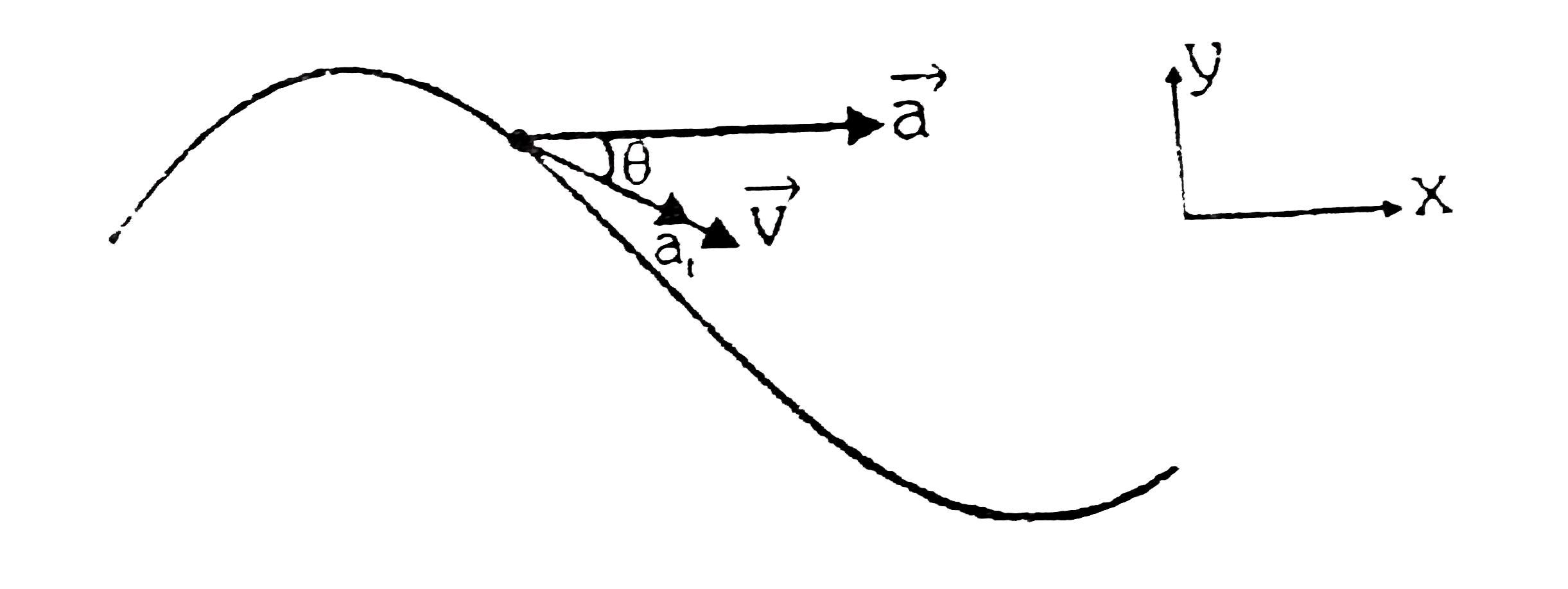Two particles of equal mass have velocities →v1=2ˆi=m/s−1 and →v2=2ˆjm/s−1. First particle has an acceleration →a1=(3ˆi+3ˆj)ms−2 while the acceleration of the other particle is zero. The centre of mass of the two particles moves in a path of.
straight line
parabola
circle
ellipse
The correct Answer is:A
To solve the problem, we need to determine the path of the center of mass of two particles given their velocities and accelerations. Here’s a step-by-step breakdown of the solution:
Step 1: Identify the velocities of the particles
The velocities of the two particles are given as:
- Particle 1: →v1=2^im/s
- Particle 2: →v2=2^jm/s
Step 2: Calculate the velocity of the center of mass
The formula for the velocity of the center of mass (→vcm) of two particles of equal mass is:
→vcm=m→v1+m→v2m+m=→v1+→v22
Substituting the values:
→vcm=2^i+2^j2=^i+^jm/s
Step 3: Identify the accelerations of the particles
The accelerations of the particles are:
- Particle 1: →a1=3^i+3^jm/s2
- Particle 2: →a2=0m/s2
Step 4: Calculate the acceleration of the center of mass
The formula for the acceleration of the center of mass (→acm) is:
→acm=m→a1+m→a2m+m=→a1+→a22
Substituting the values:
→acm=(3^i+3^j)+02=3^i+3^j2=32^i+32^jm/s2
Step 5: Analyze the direction of velocity and acceleration
The velocity of the center of mass is ^i+^j, and the acceleration of the center of mass is 32^i+32^j. Both the velocity and acceleration vectors point in the same direction (the first quadrant).
Step 6: Conclusion
Since the velocity and acceleration of the center of mass are in the same direction, the center of mass will move in a straight line.
Thus, the answer is:
The center of mass of the two particles moves in a straight line.
The velocities of the two particles are given as:
- Particle 1: →v1=2^im/s
- Particle 2: →v2=2^jm/s
The formula for the velocity of the center of mass (→vcm) of two particles of equal mass is:
→vcm=m→v1+m→v2m+m=→v1+→v22
Substituting the values:
→vcm=2^i+2^j2=^i+^jm/s
The accelerations of the particles are:
- Particle 1: →a1=3^i+3^jm/s2
- Particle 2: →a2=0m/s2
The formula for the acceleration of the center of mass (→acm) is:
→acm=m→a1+m→a2m+m=→a1+→a22
Substituting the values:
→acm=(3^i+3^j)+02=3^i+3^j2=32^i+32^jm/s2
The velocity of the center of mass is ^i+^j, and the acceleration of the center of mass is 32^i+32^j. Both the velocity and acceleration vectors point in the same direction (the first quadrant).
Since the velocity and acceleration of the center of mass are in the same direction, the center of mass will move in a straight line.
The center of mass of the two particles moves in a straight line.
Topper's Solved these Questions
- BOOK - A2ZCHAPTER - ROTATIONAL DYNAMICSEXERCISE - Moment Of Inertia39videos
ROTATIONAL DYNAMICS
- BOOK - A2ZCHAPTER - ROTATIONAL DYNAMICSEXERCISE - Rotational Kinematics19videos
ROTATIONAL DYNAMICS
- BOOK - A2ZCHAPTER - ROTATIONAL DYNAMICSEXERCISE - Chapter Test29videos
ROTATIONAL DYNAMICS
- BOOK - A2ZCHAPTER - PROPERTIES OF MATTEREXERCISE - Chapter Test29videos
PROPERTIES OF MATTER
- BOOK - A2ZCHAPTER - THERMAL PROPERTIES OF MATTEREXERCISE - Chapter Test30videos
THERMAL PROPERTIES OF MATTER
Similar Questions
Knowledge Check
- Question 1 - Select One
Two particles of equal masses have velocities →v1=8ˆi and →v2=8ˆj. First particle has an acceleration →a1=(5ˆi+5ˆj)ms−2 while the acceleration of the other particle is zero. The centre of mass of the two particles moves is a path of
Astraight lineBparabolaCcircleDellipse - Question 2 - Select One
Two particles of equal masses have velocities →v1=4ˆi and →v2=4ˆj. First particle has an acceleration →a1=(5ˆi+5ˆj)ms−2 while the acceleration of the other particle is zero. The centre of mass of the two particles moves in a path of
Astraight lineBparabolaCcircleDellipse - Question 3 - Select One
Two particles of equal masses have velocities →v1=4ˆiand→v2=4ˆj . First particle hac an acceleration of the other particle is zero . The centre of mass of the two particles moves in a path of
AStraight lineBParabolaCCircleDEllipse
A particle moves with a tangential acceleration at=→a.ˆv where →a=(5ˆi)m/s2. If the speed of the particle is zero at x=0, then find v (in m/s) at x=4.9m.
 View Solution
View SolutionA particle of mass 2√5Kg is having velocity →v=(2ˆi+ˆj)ms" and acceleration →a=(ˆj−ˆi)ms2" at some instant of time. At same instant find component of net force (in N) parallel to velocity.
View SolutionVelocity of a particle is v=(2ˆi+3ˆj−4ˆk)m/s and its acceleration is zero. State whether it is 1-D, 2-D or 3-D motion?
View SolutionThe velocities of two particles AandB of same mass are →VA=aˆi and →VB=bˆj where a and b are constants. The acceleration of particle A is (2aˆi+4bˆj) and acceleration of particle B is (aˆi−4bˆj) in (m/s2). The centre of mass of two particle will move in :
View SolutionA particle has initial velocity (3ˆi+4ˆj) and has acceleration (0.1ˆi+0.3ˆj). Its speed after 10s is.
View Solution

